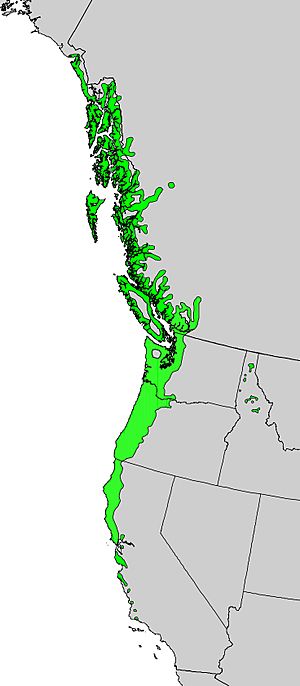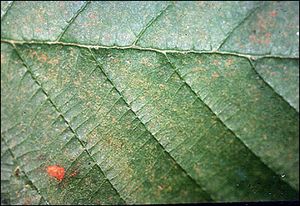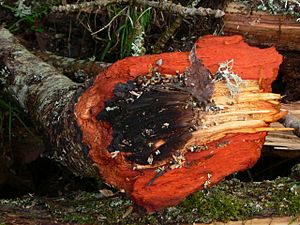Red alder facts for kids
Quick facts for kids Red alder |
|
|---|---|
 |
|
| Red alder leaves | |
| Conservation status | |
| Scientific classification | |
| Genus: |
Alnus
|
| Species: |
rubra
|
 |
|
| Natural range of Alnus rubra | |
| Synonyms | |
|
|
The red alder (scientific name: Alnus rubra) is a type of deciduous tree. This means it's a broadleaf tree that loses its leaves every autumn. It grows naturally in western North America, including places like Alaska, British Columbia, Washington, Oregon, and California.
Contents
What Does Red Alder Look Like?
Red alder is the biggest type of alder tree in North America. It can grow very tall, usually between 20 to 30 meters (about 65 to 100 feet) high. The tallest one ever recorded was 32 meters (105 feet) tall!
The tree gets its name because its bark turns a bright rusty red color if it gets bruised or scraped. The bark is usually smooth and gray, often covered with white lichen and moss.
Leaves and Flowers
Red alder leaves are shaped like an oval, about 7 to 15 centimeters (3 to 6 inches) long. They have bumpy, saw-like edges and a pointy tip. A special feature is that the very edge of the leaf is curled under. In autumn, the leaves turn yellow before they fall off.
In early spring, the male flowers appear as long, reddish, dangling parts called catkins. They are about 10 to 15 centimeters (4 to 6 inches) long. The female flowers grow in small groups. These female flowers later turn into small, woody, cone-like fruits, about 2 to 3 centimeters (1 to 1.2 inches) long. Inside these 'cones' are the seeds.
Seeds
Red alder seeds are shed in late autumn and winter. They have a thin, wing-like edge. This special wing helps the seeds fly far away in the wind, spreading the tree to new places.
Where Does Red Alder Grow?
Red alder trees grow from southeastern Alaska all the way down to central coastal California. They usually grow close to the Pacific Ocean, within about 200 kilometers (125 miles) of the coast. However, they can also be found further inland in Washington, Oregon, and northern Montana.
How Red Alder Helps Nature
In cool, wet areas like southern Alaska and British Columbia, red alder grows on moist hillsides. In drier places, like California, it mostly grows along rivers, streams, and in wet areas.
Friends in the Forest
Red alder often grows near other large trees. These include coast Douglas-fir, western hemlock, grand fir, western redcedar, and Sitka spruce.
Along riverbanks, you might find red alder growing with willows, red osier dogwood, Oregon ash, and bigleaf maple.
Where Else Does It Grow?
In some areas, other types of alder trees take the place of red alder. For example, to the southeast, you might find white alder. It looks similar but its leaves are different and its seeds don't have wings. In high mountains, smaller, bush-like Sitka alder grows. East of the Cascade Mountains, you might see thinleaf alder.
A Forest Pioneer
Red alder is known as a "pioneer species." This means it's one of the first trees to grow quickly in areas where the forest has been disturbed. For example, after a forest fire or when an area has been cleared of trees, red alder seeds can quickly sprout.
It produces many seeds, but these tiny, wind-blown seeds need open, bare soil to sprout. So, places like logging trails or areas burned by fire are perfect spots for new red alder trees to start growing. In the first year after a disturbance, hundreds of thousands of young red alder trees can sprout in just one hectare!
Food for Animals
The twigs and buds of red alder are eaten by some animals. Deer and elk nibble on the twigs in fall and the buds and twigs in winter and spring. Beavers sometimes eat the bark, but it's not their favorite food. Several types of finches, like the common redpoll and pine siskin, eat alder seeds. Deer mice also enjoy the seeds.
Making Soil Healthy
Red alder trees have a special superpower! Their roots host tiny living things called Frankia. These Frankia help the alder tree "fix" nitrogen from the air into the soil. This process is called nitrogen fixation. It means the alder can grow well even in soils that don't have much nitrogen, which is an important nutrient for plants.
When alder leaves fall in autumn, they break down quickly. This creates a rich, nitrogen-filled soil called humus, which helps other plants grow too.
How People Use Red Alder

Natural Dye
Native American people used to make a reddish-brown dye from the bark of the red alder. They used this dye to color their fishing nets. This made the nets harder for fish to see underwater.
Traditional Medicine
Long ago, Native Americans used red alder bark to help with things like poison oak rashes, insect bites, and other skin problems. Some groups, like the Blackfeet Indians, used a special tea made from the bark to treat problems with the body's lymphatic system and even tuberculosis. Modern studies have found that red alder contains natural compounds that might help fight certain tumors.
Helping Damaged Land
Because red alder can add nitrogen to the soil, it's very important for helping forests and riverbanks recover after they've been disturbed. It grows fast and can help cover land that has been damaged, like areas where mining has taken place.
Sometimes, red alder is planted in a rotation with other trees like Douglas-fir. This helps to stop a root disease called laminated root rot from spreading.
Red alder trees are also sometimes planted in gardens as ornamental trees. They grow well in wet areas like swales or along stream banks, especially in soil that drains well. However, they don't like heavy, wet clay soils. If you plant them near your home, make sure they are far away from drainpipes or water lines, as their roots can grow into and block them.
Wood for Many Things
Red alder wood is not usually used for outdoor things because it doesn't last as long as some other woods. But it's easy to work with and takes finishes well, so it's becoming popular for making furniture and cabinetry. It's softer than woods like maple or walnut, but it's also more affordable.
Some people who build musical instruments, especially electric guitars and basses, like red alder wood because it gives a balanced sound. Native Americans also used alder wood to make masks, bowls, tool handles, and other small items.
The wood itself can be white, pinkish, or light brown. It has a soft feel, not much visible grain, and a medium shine. It's easy to cut, glue, and finish.
Smoking Fish
Because of the oily smoke it produces, red alder wood is a top choice for smoking salmon.
A Sign of Clean Air?
Scientists sometimes use red alder as a "biomonitoring" plant. This means they watch the leaves to see if there's a lot of ozone pollution in the air. If there are high levels of ozone, the leaves can develop red, brown, or purple spots.
Forestry
Red alder is a very important hardwood tree in the Pacific Northwest region. It makes up a large part of the hardwood forests there. Because its wood is becoming more valuable, some forest managers are now choosing to grow and manage alder trees.
Red alder grows very quickly when it's young. This fast growth can sometimes make it harder for other trees, like conifers, to get established.
Besides adding nitrogen to the soil, growing red alder trees in rotation can help reduce a root disease called laminated root rot in Douglas-fir forests.
Images for kids








